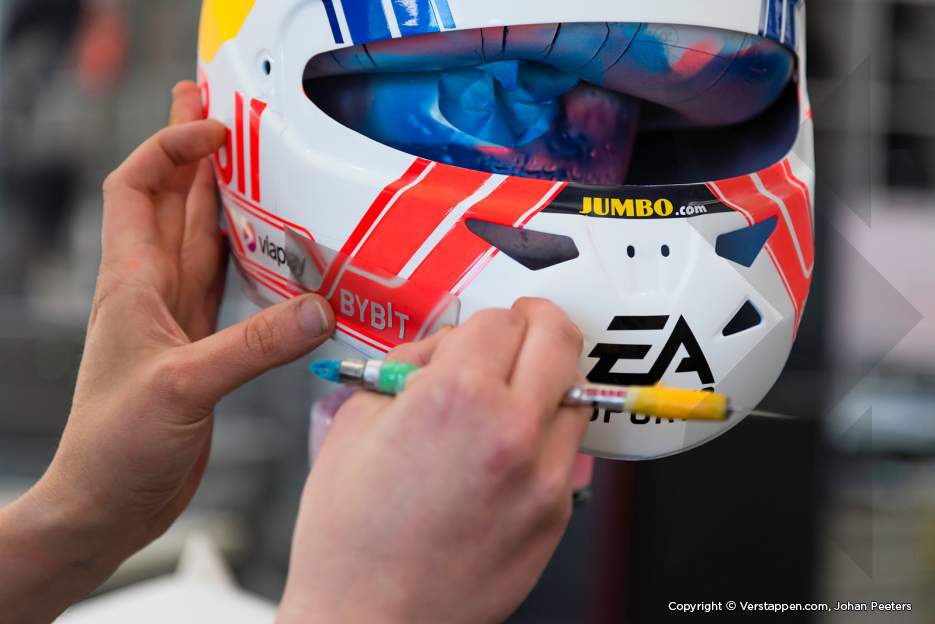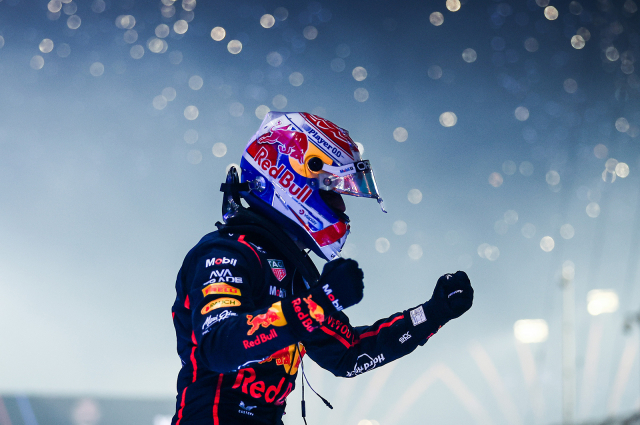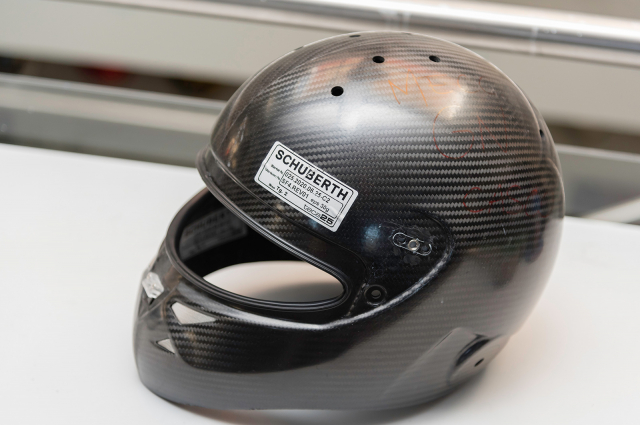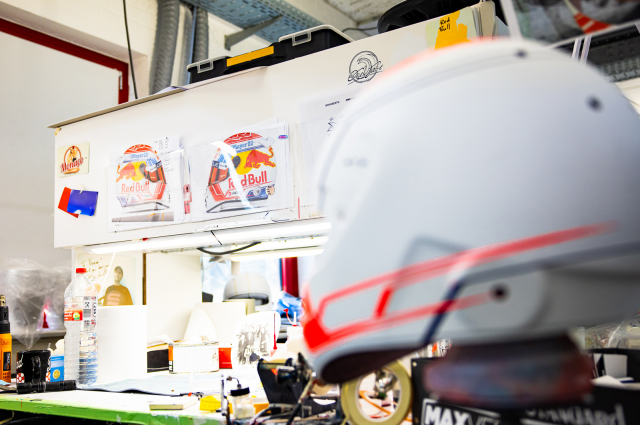How does Max' helmet come about?
Published on 12 April 2023 by Heidi De Love
Verstappen.com already paid attention to it earlier this year: the helmets worn by Max Verstappen over the course of the entire Formula 1 season. At the beginning of the year, a team from Verstappen.com was able to meet the man, and his company, who has been responsible for painting Max' helmets since the beginning of his Formula 1 career: Jens Munser Designs.
Jens takes us through his company and shows us from start to finish how the spraying of a helmet of Max is done. To show us the whole process, which normally takes several days, in one day, Jens has prepared two helmet shells that are both at different stages. The first shell is mostly taped off and ready for spraying in red the parts that need to be red. The second shell is further along in the process and already provided with the red colour. This shell is taped off to spray the parts that need to be blue.
 As a base, Schuberth, the helmet manufacturer, supplies a black carbon shell. A coat of silver paint is sprayed on this as a base, followed by a white coat of paint. “Silver covers the black better”, Jens explains. “If you only spray white on a black helmet, you need three coats of white to get the whole thing covered.”
As a base, Schuberth, the helmet manufacturer, supplies a black carbon shell. A coat of silver paint is sprayed on this as a base, followed by a white coat of paint. “Silver covers the black better”, Jens explains. “If you only spray white on a black helmet, you need three coats of white to get the whole thing covered.”
Once the base paint has dried, markings are then made with pencil where the lines and sponsor logos should go. Transferring the design from the drawing to the helmet is therefore the most complex part according to Jens, as you move from a 2D drawing to a 3D surface: “We have tried to do this with a projector or laser machine in the past, but given the many types and sizes of helmets, this proved impossible. We work with a plastic mould around the helmet with cutouts in it to apply the pencil markings, this method dates back to when we made Michael Schumacher's helmets. This works perfectly to ensure that the design is transferred in the best possible way and that two helmets are also exactly the same in the end.”
 After applying the pencil lines, the parts of the helmet where no paint should get on are then covered with tape. Some lines are also applied directly with decals, as this is more precise than spraying. The distinctive lion on the top of Max's helmet is also applied with a decal. The white background that remains covered by the sticker eventually forms the lion, while the rest around it is sprayed red.
After applying the pencil lines, the parts of the helmet where no paint should get on are then covered with tape. Some lines are also applied directly with decals, as this is more precise than spraying. The distinctive lion on the top of Max's helmet is also applied with a decal. The white background that remains covered by the sticker eventually forms the lion, while the rest around it is sprayed red.
The first colour sprayed on the white helmet is fluorescent red. After spraying in the spray booth, the helmet goes into a drying oven for one minute before one more coat of fluorescent red is applied. Once this has dried, the helmet is taped again to cover all parts that should not turn blue. After this, the blue metallic paint is also applied to the helmet. For each colour that appears on the helmet, the helmet has to be taped off completely in those areas that should not be sprayed in the respective colour. It is fascinating to see how skillfully and precisely this process is carried out.
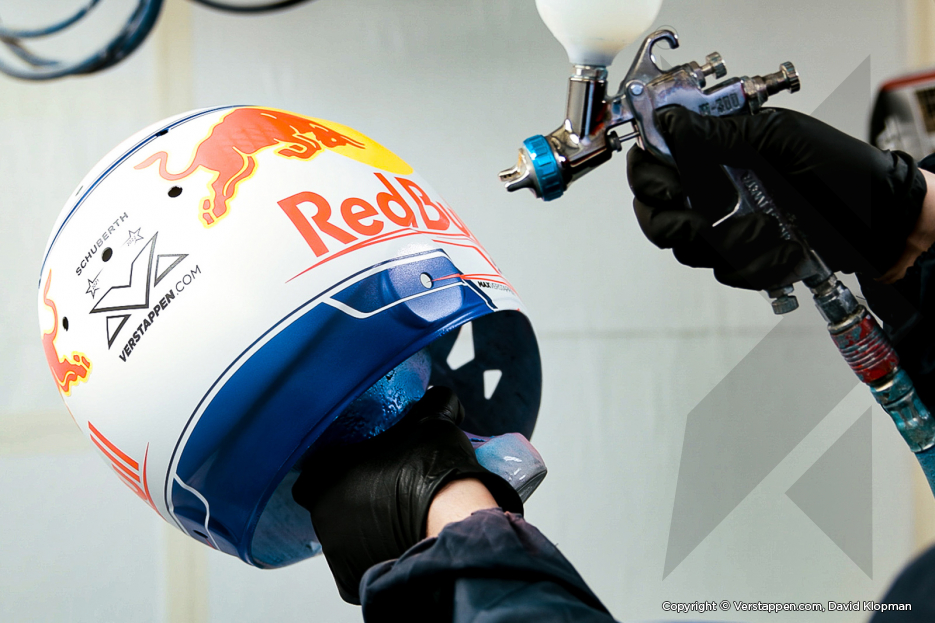 After spraying the colours, the sponsor logos are applied to the helmet with the utmost precision. Once again, the pencil marks help to place the logos in exactly the right place. A precision knife is used to remove the sticker residue and an eraser is used to wipe away the pencil marks. A coat of clearcoat, a night of drying and a final coat of clearcoat provide the finishing touch. The helmet is now ready to be shipped to Schuberth where it will be finished. Among other things, the inner liner, visor, air vents and attachment of the HANS system are still to be attached to the helmet.
After spraying the colours, the sponsor logos are applied to the helmet with the utmost precision. Once again, the pencil marks help to place the logos in exactly the right place. A precision knife is used to remove the sticker residue and an eraser is used to wipe away the pencil marks. A coat of clearcoat, a night of drying and a final coat of clearcoat provide the finishing touch. The helmet is now ready to be shipped to Schuberth where it will be finished. Among other things, the inner liner, visor, air vents and attachment of the HANS system are still to be attached to the helmet.
As the first example of a design, this helmet also serves as a model for the scale models Schubert produces in 1:2 and 1:4 exclusively for Verstappen.com. A good move according to Jens: “It's good for the fans. It is the only chance to buy a helmet, because a full-size helmet is too expensive or not available. A helmet is often the only part by which you can properly recognise a driver, and it is therefore also the only personal part of a driver.”
Click here to view the photo album of the process of spraying Max’ helmet.

